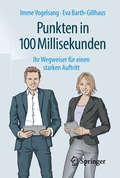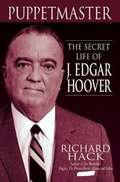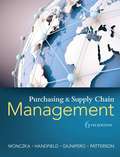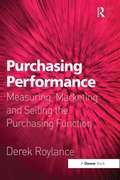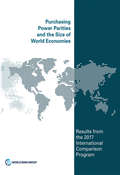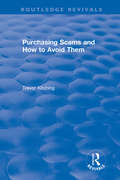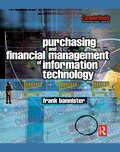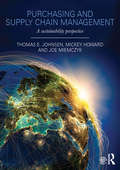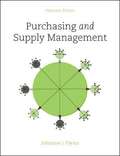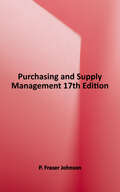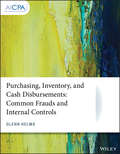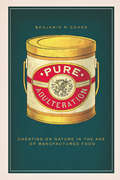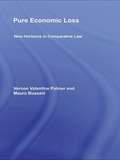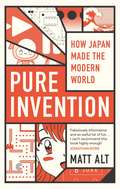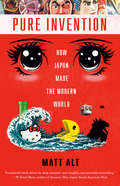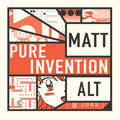- Table View
- List View
Punkten in 100 Millisekunden: Ihr Wegweiser für einen starken Auftritt
by Imme Vogelsang Eva Barth-Gillhaus Laura FölmerDieser Leitfaden für eine gelungene Selbstdarstellung bietet neben praktischen Ratschlägen unterhaltsame Ausflüge in wissenschaftliche Forschungsfelder. Studien belegen schon lange, dass Outfit und Auftreten maßgeblicher über Erfolg oder Misserfolg entscheiden als die reine Leistungsfähigkeit oder Fachkompetenz. Vor allem der erste Eindruck bestimmt, was ein Gegenüber vom anderen hält. Es lohnt sich, die Mechanismen zu kennen und anzuwenden: Persönliche Ausstrahlung und souveränes Auftreten sind für den Erfolg gerade im digitalen Zeitalter wichtiger denn je.Die Autorinnen verbinden praktische Ratschläge und Beispiele der Bereiche Kommunikation, Körpersprache und Kleidung mit soliden Ergebnissen z. B. der Hirnforschung. Sie erfahren, wie Sie vom ersten Moment an besser wahrgenommen werden und in unterschiedlichen Alltags und Business-Situationen mehr Wirkung ausstrahlen – übrigens auch bei Videokonferenzen auf dem Bildschirm. Die 2. Auflage wurde überarbeitet und um ein Kapitel zur neuen Lockerheit ergänzt.
Punktlandung im Vertrieb: Wie Sie den Kunden zielsicher zum Abschluss führen
by Ralph GuttenbergerSie verkaufen erklärungsbedürftige Produkte oder beratungsintensive Dienstleistungen? Dann verfügen Sie über ein Fachwissen, das weit über das jedes Kunden hinausgeht. Wie ein Passagier im Flugzeug auf den Piloten, ist Ihr Kunde auf Sie als Verkäufer angewiesen, der ihn verantwortlich und sicher ans Ziel – zum Abschluss – führen muss. Wie Sie einen erfolgreichen Vertriebsprozess aufbauen, zeigt Ihnen Ralph Guttenberger in diesem Praxis-Ratgeber. Der erfolgreiche Vertriebstrainer und ehemalige Jetpilot vergleicht Verkaufen mit Fliegen und erläutert Schritt für Schritt den gesteuerten Verkaufsprozess vom Start bis zur Landung – also durchgeplant vom Erstkontakt bis zur geführten Kaufentscheidung. Kommen Sie an Bord und starten Sie das Flug-Training! Erfolgreiche Landung garantiert! »Den Bereich >Verkauf >Punktlandung Dr. h. c. Dieter Fröhlich, Präsident des Deutschen Franchise-Verbandes e.V. »Der Verkäufer erhält eine Fülle von sofort umsetzbaren Praxistipps und Checklisten, mit denen Verkaufen effektiver und einfacher wird. Wenig Theorie, viel umsetzbare Praxis, aufgelockert durch nachdenkenswerte Geschichten. Mein Urteil: rundum lesenswert.« Jürgen Dawo, Geschäftsführer Town & Country Franchise-International
Puppetmaster: The Secret Life of J. Edgar Hoover
by Richard HackBiography of the former FBI director, who led and influenced it for so many years.
Purchasing And Supply Chain Management (Sixth Edition)
by Robert B. Handfield Robert M. Monczka Larry C. Giunipero James L. PattersonProviding a solid managerial perspective, PURCHASING AND SUPPLY CHAIN MANAGEMENT, 6e draws from the authors' firsthand experiences and relationships with executives and practitioners worldwide to present the most current and complete coverage of today's supply management process. The text includes critical developments from the field, such as cases from emerging healthcare and service industries, procure-to-pay redesign, supply risk, innovation, sustainability, collaboration, and much more. Students examine key changes in supply management and the impact of the global economy and ongoing business uncertainty on continuous cost and value management across the supply chain. Numerous real-world cases and captivating examples help students gain contextual insights and knowledge into the strategies, processes, and practices of supply management--giving these future managers a thorough understanding of the impact that purchasing and supply chain management have on the competitive success and profitability of today's organizations.
Purchasing Medical Innovation
by James C. RobinsonInnovation in medical technology generates a remarkable supply of new drugs, devices, and diagnostics that improve health, reduce risks, and extend life. But these technologies are too often used on the wrong patient, in the wrong setting, or at an unaffordable price. The only way to moderate the growth in health care costs without undermining the dynamic of medical innovation is to improve the process of assessing, pricing, prescribing, and using new technologies. Purchasing Medical Innovation analyzes the contemporary revolution in the purchasing of health care technology, with a focus on the roles of the Food and Drug Administration (FDA), Medicare and private health insurers, physicians and hospitals, and consumers themselves. The FDA is more thoroughly assessing product performance under real-world conditions as well as in laboratory settings, accelerating the path to market for breakthroughs while imposing use controls on risky products. Insurers are improving their criteria for coverage and designing payment methods that reward efficiency in the selection of new treatments. Hospitals are aligning adoption of complex supplies and equipment more closely with physicians' preferences for the best treatment for their patients. Consumers are becoming more engaged and financially accountable for their health care choices. This book describes both the strengths and deficiencies of the current system of purchasing and highlights opportunities for buyers, sellers, and users to help improve the value of medical technology: better outcomes at lower cost.
Purchasing Must Become Supply Management
by Peter KraljicThreats of resource depletion and raw materials scarcity, political turbulence and government intervention in supply markets, intensified competition, and accelerating technological change can upset supply and demand patterns suddenly. Companies must shift their perspective from purchasing (an operating function) to supply management (a strategic one) to ensure continued supply of materials. Companies must integrate purchasing with other elements of the business system.
Purchasing Performance: Measuring, Marketing and Selling the Purchasing Function
by Derek RoylanceIf the only measure of your organization's purchasing performance is forcing down prices from suppliers then not only is your purchasing team failing to add value, they may also be damaging your supply chain and the medium to long-term competitiveness of your organization. Derek Roylance's Purchasing Performance - Measuring, Marketing and Selling the Purchasing Function is a blueprint to help you identify the performance measures and marketing expertise that matter for your purchasing team. Buyers don't exist in isolation but often find it easier to focus excessively on the external market place leading to neglect and subsequent alienation of their internal customers. The book recommends operating the function as a business within a business. Part of this approach is to increase market share by better internal marketing and selling of their procurement expertise. The author provides practical methods for measuring purchasing performance and then communicating effectively - to the whole organization - the contribution the function can make to increase competitive advantage, profitability and all-round efficiency. In an intensely competitive world marketplace, purchasing can only achieve its true potential if it can persuade top decision makers that it will pay them to involve their procurement specialists in all major strategic decisions; the book shows how to achieve this top-level influence.
Purchasing Power Parities and the Size of World Economies: Results from the 2017 International Comparison Program (International Comparison Program)
by World Bank GroupThe International Comparison Program (ICP) is a worldwide statistical initiative led by the World Bank under the auspices of the United Nations Statistical Commission. It produces comparable price and volume measures of gross domestic product (GDP) and its expenditure aggregates across economies. Through a partnership with international, regional, sub-regional and national agencies, the ICP collects price data and GDP expenditures to estimate purchasing power parities (PPPs) for the world’s economies. The report provides ICP results for the benchmark year 2017 and revised results for earlier years. ICP data are used for socio-economic analyses by researchers, academics, policy makers at the national and international levels, and by organizations such as the European Union, the International Monetary Fund, the Organization for Economic Co-operation and Development, the United Nations, and the World Bank. Notably, PPPs and ICP data are used in indicators monitoring progress towards eight goals of the United Nations’ 2030 Agenda for Sustainable Development, the World Bank’s international poverty lines, and the construction of the Human Development Index by the United Nations, among others. The use of PPPs continues to grow and the ICP website (icp.worldbank.org) lists many applications of the data by the development community, academia, media and others.
Purchasing Power: The Economics of Modern Jewish History (Jewish Culture and Contexts)
by Rebecca Kobrin Adam TellerHow has the ability of Jews to amass and wield power, within both Jewish and non-Jewish society, influenced and been influenced by their economic activity? Purchasing Power answers this question by examining the nexus between money and power in modern Jewish history. It does so, in its first section, by presenting a series of case studies of the ways in which the economic choices made by Jewish businessmen could bring them wealth and influence. The second section focuses on transnational Jewish philanthropic and economic networks. The discussions there reveal how the wielding of power by Jewish organizations on the world stage could shape not only Jewish society but also the international arena.In this way, the contributors to this volume reposition economics as central to our understanding of the Jewish experience from early modern Rome to contemporary America. Its importance for the creation of the State of Israel is also examined. As the editors write: "The study of culture and identity has proved valuable and enlightening (and, in some senses, also comfortable) in understanding the complexities of Jewish history. Perhaps we should now return to the issues of the material bases for Jewish life, and the ways in which Jews have exploited them in their search for wealth and power. Our understanding of the Jewish past will be immeasurably enriched in the effort."Contributors: Cornelia Aust, Bernard Cooperman, Veerle Vanden Daelen, Jonathan Dekel-Chen, Glenn Dynner, Abigail Green, Jonathan Karp, Rebecca Kobrin, Adam D. Mendelsohn, Derek Penslar, Adam Sutcliffe, Adam Teller, Carsten L. Wilke.
Purchasing Scams and How to Avoid Them (Routledge Revivals)
by Trevor KitchingThis title was first published in 2001. Purchasing scams are not a high profile topic in the boardroom or indeed in the purchasing department - victims don’t like to talk about their experience. They don’t want to admit that they were gullible enough to be fooled by a fake invoice or a plausible appeal for a bogus charity. And yet scams cost companies thousands of pounds every year! Purchasing Scams and How to Avoid Them provides a comprehensive and practical guide to avoiding scams in the first place: any initiative in relation to scams must focus on prevention rather than cure. It contains descriptions of all of the most common scams including bogus directories, over-priced office consumables and business consultants who are too good to be true. It also describes how the infamous and ubiquitous Nigeria scam works. Advice is given on how to avoid each and, most importantly, how to establish a purchasing function that will provide effective defences against the perpetrators of such operations.
Purchasing a Business: The Search Process
by Michael J. Roberts Ennis J. WaltonDescribes the steps necessary to purchase a small to medium size company. Provides an eight-part analytical framework. Issues covered in the framework include the following: the self-assessment, deal criteria, deal sources, resources necessary to purchase a business, the deal process, the evaluation process, negotiating the deal, and adding value and harvesting the venture.
Purchasing and Financial Management of Information Technology
by Frank BannisterPurchasing and Financial Management of Information Technology aims to significantly reduce the amount of money wasted on IT by providing readers with a comprehensive guide to all aspects of planning, managing and controlling IT purchasing and finance. Starting from a recognition that IT purchasing and the financial management often needs to be treated differently from other types of expenditure, the author draws on over 25 years of experience in the field to provide readers with useful mixture of good procedures and common sense rules that have been tried, tested and found to work. Many of these are illustrated by case histories, each with a moral or a lesson.Purchasing and Financial Management of Information Technology provides useful guidelines and advice on whole range of topics including:* IT acquisitions policy* Dealing with suppliers* Budgeting and cost control* IT cost and risk management* Specification, selection and evaluation of systems* IT value for money
Purchasing and Supply Chain Management
by W. C. BentonPurchasing and Supply Chain Management introduces students to purchasing as it relates to the supply chain and other functions and systems within an organization, such as marketing, logistics, and operations. Author W. C. Benton, Jr. draws from more than 30 years of practice, instruction, research, and consulting experience to teach students proactive collaboration, negotiation, and analytics. Through a step-by-step approach, readers will gain data-driven purchasing skills crucial for the next generation of professionals. <!-- /* Font Definitions */ @font-face {font-family:"Cambria Math"; panose-1:2 4 5 3 5 4 6 3 2 4; mso-font-charset:0; mso-generic-font-family:roman; mso-font-pitch:variable; mso-font-signature:-536870145 1107305727 0 0 415 0;} @font-face {font-family:Tahoma; panose-1:2 11 6 4 3 5 4 4 2 4; mso-font-charset:0; mso-generic-font-family:swiss; mso-font-pitch:variable; mso-font-signature:-520081665 -1073717157 41 0 66047 0;} @font-face {font-family:"Segoe UI"; panose-1:2 11 6 4 2 2 2 2 2 4; mso-font-alt:Sylfaen; mso-font-charset:0; mso-generic-font-family:swiss; mso-font-pitch:variable; mso-font-signature:-469750017 -1073683329 9 0 511 0;} /* Style Definitions */ p.MsoNormal, li.MsoNormal, div.MsoNormal {mso-style-unhide:no; mso-style-qformat:yes; mso-style-parent:""; margin:0in; mso-pagination:widow-orphan; font-size:10.0pt; font-family:"Tahoma",sans-serif; mso-fareast-font-family:"Times New Roman"; mso-bidi-font-family:"Times New Roman";} .MsoChpDefault {mso-style-type:export-only; mso-default-props:yes; font-size:10.0pt; mso-ansi-font-size:10.0pt; mso-bidi-font-size:10.0pt;}size:8.5in 11.0in; margin:1.0in 1.0in 1.0in 1.0in; mso-header-margin:.5in; mso-footer-margin:.5in; mso-paper-source:0;} div.WordSection1 {page:WordSection1;}
Purchasing and Supply Chain Management
by W. C. BentonPurchasing and Supply Chain Management introduces students to purchasing as it relates to the supply chain and other functions and systems within an organization, such as marketing, logistics, and operations. Author W. C. Benton, Jr. draws from more than 30 years of practice, instruction, research, and consulting experience to teach students proactive collaboration, negotiation, and analytics. Through a step-by-step approach, readers will gain data-driven purchasing skills crucial for the next generation of professionals. <!-- /* Font Definitions */ @font-face {font-family:"Cambria Math"; panose-1:2 4 5 3 5 4 6 3 2 4; mso-font-charset:0; mso-generic-font-family:roman; mso-font-pitch:variable; mso-font-signature:-536870145 1107305727 0 0 415 0;} @font-face {font-family:Tahoma; panose-1:2 11 6 4 3 5 4 4 2 4; mso-font-charset:0; mso-generic-font-family:swiss; mso-font-pitch:variable; mso-font-signature:-520081665 -1073717157 41 0 66047 0;} @font-face {font-family:"Segoe UI"; panose-1:2 11 6 4 2 2 2 2 2 4; mso-font-alt:Sylfaen; mso-font-charset:0; mso-generic-font-family:swiss; mso-font-pitch:variable; mso-font-signature:-469750017 -1073683329 9 0 511 0;} /* Style Definitions */ p.MsoNormal, li.MsoNormal, div.MsoNormal {mso-style-unhide:no; mso-style-qformat:yes; mso-style-parent:""; margin:0in; mso-pagination:widow-orphan; font-size:10.0pt; font-family:"Tahoma",sans-serif; mso-fareast-font-family:"Times New Roman"; mso-bidi-font-family:"Times New Roman";} .MsoChpDefault {mso-style-type:export-only; mso-default-props:yes; font-size:10.0pt; mso-ansi-font-size:10.0pt; mso-bidi-font-size:10.0pt;}size:8.5in 11.0in; margin:1.0in 1.0in 1.0in 1.0in; mso-header-margin:.5in; mso-footer-margin:.5in; mso-paper-source:0;} div.WordSection1 {page:WordSection1;}
Purchasing and Supply Chain Management: A Sustainability Perspective
by Thomas E. Johnsen Mickey Howard Joe MiemczykThis is the ground-breaking new book for aspiring purchasing and supply chain leaders and anyone with a keen interest in this rapidly evolving field. For too long business has focused on short-term cost advantages through low-cost country sourcing with little regard for the longer-term implications of global sustainability. As the first book to fully address the environmental, social and economic challenges of how companies manage purchasing and supply chains, it aims to inspire the development of current and future purchasing and supply chain leaders. In addition to explaining the basic principles and processes of both purchasing and supply chain management, the book evaluates how to develop strategic and sustainable purchasing and supply chain management. A key message is that purchasing and supply chain management needs to focus on value creation rather than cost cutting. This requires the development of completely new purchasing and supply chain models that involve closed-loop supply structures, supply chain transparency and collaboration with new stakeholders in traditional sourcing and supply chain processes. Aimed at students, educators and practitioners the book integrates sustainability into each chapter as a core element of purchasing and supply chain management. Incorporating case studies from industry into each chapter, the book strikes a balance between theoretical frameworks and guidelines for implementation in practice.
Purchasing and Supply Chain Management: A Sustainability Perspective
by Thomas E. Johnsen Mickey Howard Joe MiemczykFor too long, business has focused on short-term cost advantages through low-cost country sourcing with little regard for the longer-term implications of global sustainability. Purchasing and Supply Chain Management, Second Edition, not only fully addresses the environmental, social and economic challenges of how companies manage purchasing and supply chains, but also delves deeper into emerging areas such as modern slavery, digital technologies and circular supply chains. In addition to explaining the basic principles and processes of both purchasing and supply chain management, the book evaluates how to develop strategic and sustainable purchasing and supply chain management. Our key message is that purchasing and supply chain management needs to focus on value creation rather than cost cutting. This requires the development of new purchasing and supply chain models that involve circular supply structures, supply chain transparency and collaboration with new stakeholders in traditional sourcing and supply chain settings. Aimed at students, educators and practitioners the book integrates sustainability into each chapter as a core element of purchasing and supply chain management. This second edition incorporates new examples and case studies from industry throughout, striking a balance between theoretical frameworks and guidelines for implementation in practice.
Purchasing and Supply Management
by P. Fraser Johnson Anna E. FlynnThe text focuses on decision making throughout the supply chain. Based on the conviction that supply managers, in concert with suppliers and distributors, have to contribute to organizational goals and strategies, this edition continues to focus on how to make that mission a reality.
Purchasing and Supply Management
by P. Fraser JohnsonThis new edition provides an opportunity to incorporate the latest theory and best practices in supply chain management into the text. Wherever appropriate, real-world examples and current research are used to illustrate key points. Second, the application of information technology to supply chain processes continues to change rapidly, including the evolution of cloud-based computing, digitization, and blockchain. New supply chain finance technologies can improve buyer working capital utilization and reduce risks by providing suppliers with alternatives for managing their cash flow and liquidity. Third, there are also several important emerging issues--including the challenges of managing sustainability, risks in global supply chains, and supplier diversity--that are addressed in this text.
Purchasing, Inventory, and Cash Disbursements: Common Frauds and Internal Controls (AICPA)
by Glenn HelmsPurchasing, Inventory, and Cash Disbursements: Common Frauds and Internal Controls by Glenn Helms
Pure Adulteration: Cheating on Nature in the Age of Manufactured Food
by Benjamin R. CohenBenjamin R. Cohen uses the pure food crusades at the turn of the twentieth century to provide a captivating window onto the origins of manufactured foods in the United States. In the latter nineteenth century, extraordinary changes in food and agriculture gave rise to new tensions in the ways people understood, obtained, trusted, and ate their food. This was the Era of Adulteration, and its concerns have carried forward to today: How could you tell the food you bought was the food you thought you bought? Could something manufactured still be pure? Is it okay to manipulate nature far enough to produce new foods but not so far that you question its safety and health? How do you know where the line is? And who decides? In Pure Adulteration, Benjamin R. Cohen uses the pure food crusades to provide a captivating window onto the origins of manufactured foods and the perceived problems they wrought. Cohen follows farmers, manufacturers, grocers, hucksters, housewives, politicians, and scientific analysts as they struggled to demarcate and patrol the ever-contingent, always contested border between purity and adulteration, and as, at the end of the nineteenth century, the very notion of a pure food changed. In the end, there is (and was) no natural, prehuman distinction between pure and adulterated to uncover and enforce; we have to decide. Today’s world is different from that of our nineteenth-century forebears in many ways, but the challenge of policing the difference between acceptable and unacceptable practices remains central to daily decisions about the foods we eat, how we produce them, and what choices we make when buying them.
Pure Economic Loss: New Horizons in Comparative Law (UT Austin Studies in Foreign and Transnational Law)
by Mauro Bussani Vernon Valentine PalmerPure economic loss is one of the most-discussed problems in the fields of tort and contract. How do we understand the various differences and similarities between these systems and what is the extent to which there is a common-core of agreement on this question? This book takes a comparative approach to the subject, exploring the principles, policies and rules governing tortious liability for pure economic loss in a number of countries and legal systems across the world. The countries covered are USA, Canada, Japan, Israel, South Africa, Japan, Romania, Croatia, Denmark and Poland, with the contributors taking a comparative fact-based approach through the use of hypothetical problems to analyze and then summarize the individual country’s tort approach. Using a fact-based questionnaire, a tested taxonomy, and a sophisticated comparative law methodology, the authors convincingly demonstrate that there are liberal, pragmatic and conservative regimes throughout the world. The recoverability of pure economic loss poses a generic question for these legal systems - it is not just a civil law versus common law issue. It will be of interest to students and academics studying tort law and comparative law in the different countries covered.
Pure Invention: How Japan's Pop Culture Conquered the World
by Matt Alt'Amazingly well researched, fabulously informative and an awful lot of fun. If you love Japanese culture or are just curious to know more I can't recommend this book highly enough' Jonathan Ross'A nerd- and generalist-friendly look at how Japan shaped the post-World War II world, from toys to Trump . . . A non-native's savvy study of Japan's wide influence in ways both subtle and profound' KirkusThe Walkman. Karaoke. Pikachu. Pac-Man. Akira. Emoji. We've all fallen in love with one or another of Japan's pop-culture creations, from the techy to the wild to the super-kawaii. But as Japanese-media veteran Matt Alt proves in this brilliant investigation of Tokyo's pop-fantasy complex, we don't know the half of it.Japan's toys, gadgets, and fantasy worlds didn't merely entertain. They profoundly transformed the way we live. In the 1970s and '80s, Japan seemed to exist in some near future, soaring on the superior technology of Sony and Toyota while the West struggled to catch up. Then a catastrophic 1990 stock-market crash ushered in the 'lost decades' of deep recession and social dysfunction.The end of the boom times should have plunged Japan into irrelevance, but that's precisely when its cultural clout soared - when, once again, Japan got to the future a little ahead of the rest of us. Hello Kitty, the Nintendo Entertainment System, and multimedia empires like Pokémon and Dragon Ball Z were more than marketing hits. Artfully packaged, dangerously cute, and dizzyingly fun, these products made Japan the forge of the world's fantasies, and gave us new tools for coping with trying times. They also transformed us as we consumed them - connecting as well as isolating us in new ways, opening vistas of imagination and pathways to revolution. Through the stories of an indelible group of artists, geniuses, and oddballs, Pure Invention reveals how Japanese ingenuity remade global culture and may have created modern life as we know it. It's Japan's world; we're just gaming, texting, singing, and dreaming in it.
Pure Invention: How Japan's Pop Culture Conquered the World
by Matt AltThe untold story of how Japan became a cultural superpower through the fantastic inventions that captured—and transformed—the world&’s imagination. &“A masterful book driven by deep research, new insights, and powerful storytelling.&”—W. David Marx, author of Ametora: How Japan Saved American StyleThe Walkman. Karaoke. Pikachu. Pac-Man. Akira. Emoji. We&’ve all fallen in love with one or another of Japan&’s pop-culture creations, from the techy to the wild to the super-kawaii. But as Japanese media veteran Matt Alt proves in this brilliant investigation of Tokyo&’s pop-fantasy complex, we don&’t know the half of it. Japan&’s toys, gadgets, and imaginary worlds didn&’t merely entertain. They profoundly transformed the way we live. In the 1970s and &’80s, Japan seemed to exist in some near future, gliding on the superior technology of Sony and Toyota while the West struggled to catch up. Then a catastrophic 1990 stock-market crash ushered in the &“lost decades&” of deep recession and social dysfunction. The end of the boom times should have plunged Japan into irrelevance, but that&’s precisely when its cultural clout soared—when, once again, Japan got to the future a little ahead of the rest of us. Hello Kitty, the Nintendo Entertainment System, and multimedia empires like Pokémon and Dragon Ball Z were more than marketing hits. Artfully packaged, dangerously cute, and dizzyingly fun, these products made Japan the forge of the world&’s fantasies, and gave us new tools for coping with trying times. They also transformed us as we consumed them—connecting as well as isolating us in new ways, opening vistas of imagination and pathways to revolution. Through the stories of an indelible group of artists, geniuses, and oddballs, Pure Invention reveals how Japanese ingenuity remade global culture and may have created modern life as we know it. It&’s Japan&’s world; we&’re just gaming, texting, singing, and dreaming in it.
Pure Invention: How Japan's Pop Culture Conquered the World
by Matt Alt'Amazingly well researched, fabulously informative and an awful lot of fun. If you love Japanese culture or are just curious to know more I can't recommend this book highly enough' Jonathan Ross'A nerd- and generalist-friendly look at how Japan shaped the post-World War II world, from toys to Trump . . . A non-native's savvy study of Japan's wide influence in ways both subtle and profound' KirkusThe Walkman. Karaoke. Pikachu. Pac-Man. Akira. Emoji. We've all fallen in love with one or another of Japan's pop-culture creations, from the techy to the wild to the super-kawaii. But as Japanese-media veteran Matt Alt proves in this brilliant investigation of Tokyo's pop-fantasy complex, we don't know the half of it.Japan's toys, gadgets, and fantasy worlds didn't merely entertain. They profoundly transformed the way we live. In the 1970s and '80s, Japan seemed to exist in some near future, soaring on the superior technology of Sony and Toyota while the West struggled to catch up. Then a catastrophic 1990 stock-market crash ushered in the 'lost decades' of deep recession and social dysfunction.The end of the boom times should have plunged Japan into irrelevance, but that's precisely when its cultural clout soared - when, once again, Japan got to the future a little ahead of the rest of us. Hello Kitty, the Nintendo Entertainment System, and multimedia empires like Pokémon and Dragon Ball Z were more than marketing hits. Artfully packaged, dangerously cute, and dizzyingly fun, these products made Japan the forge of the world's fantasies, and gave us new tools for coping with trying times. They also transformed us as we consumed them - connecting as well as isolating us in new ways, opening vistas of imagination and pathways to revolution. Through the stories of an indelible group of artists, geniuses, and oddballs, Pure Invention reveals how Japanese ingenuity remade global culture and may have created modern life as we know it. It's Japan's world; we're just gaming, texting, singing, and dreaming in it.
Purity Steel Corporation, 2012
by Robert L. Simons Antonio DavilaManagers introduce a new performance evaluation system based on sales growth and return-on-investment (ROI). A branch manager wonders whether his new warehouse should be leased to mitigate the impact on ROI. Formulas and performance calculations are provided. A rewritten version of an earlier case.
